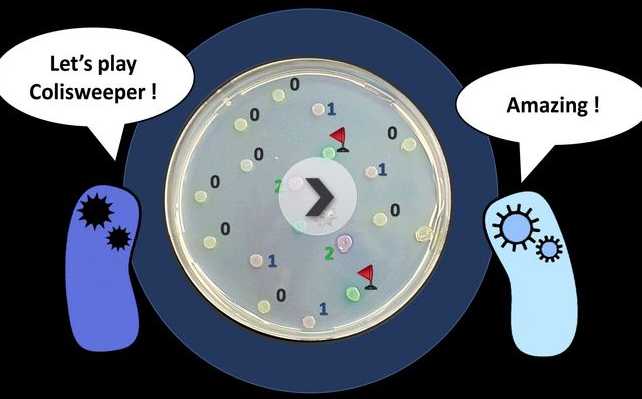Sweeping bacterial mines
Students of ETH's Department Biosystems got a gold medal at iGEM competition for their "Colisweeper". This copy of the Windows game Minesweeper can be played with E.coli bacteria.

The computer game Minesweeper is a classic and many an hour when people should have been working or revising has fallen prey to this preinstalled game on older Windows system. The aim of the game is to uncover squares in a field to sweep for mines. Unmined squares display a figure telling the player how many mines are touching that particular field. Using his or her powers of deduction, the player can thus diffuse all the mines. If you uncover a field with a mine, however, it is game over.
Minesweeper can now be played in the lab, too: a team of seven students from ETH Zurich’s Department of Biosystems (D-BSSE) has made an interactive biological version of the game: “external pageColisweepercall_made”. They entered their creation in the annual external pageiGEMcall_made competition in Synthetic Biology in Cambridge, Massachusetts – and scored a direct hit: the ETH-Zurich students received one of several gold awards for their original project and their poster was voted the best from Europe. They took the title for the best information processing project in the global competition and in a blog by Popular Science the ETH-Zurich project is even singled out as one of the nine “coolest” in the entire contest.
Mined bacteria light up blue
You don’t need a mouse or operating system to play Colisweeper. The game takes place in a culture medium in a Petri dish. For mines or unmined fields, the ETH-Zurich students used colonies of genetically modified E. coli bacteria arranged like dots in a honeycomb pattern. Bacteria that represent mines release a certain signal molecule, which non-mine bacteria absorb and process. The more mines there are around a non-mine colony, the higher the concentration of the signal molecule.
The player uncovers the fields with a pipette, which he or she uses to apply a colourless substrate to the bacteria colonies. The ones that do not have any neighbouring mines light up yellow upon absorbing the substrate. Colonies with a mine in the vicinity turn pink, those with two mines purple. If you hit a mine with the pipette, you experience a blue marvel: the corresponding bacteria colony turns blue and the game is over.
In order create the different colours, the signal molecule from a mine colony needs to be diffused throughout the culture medium and absorbed by the recipient cells, where it triggers the formation of different hydrolases (a particular class of enzymes) depending on the concentration. These enzymes transform the substrate into a dye, which colours the field accordingly.
Outstanding performance
The ETH-Zurich team comprises the Master’s students Parvathi Chandran, Meret Arter, Susana Posada Cespedes, Angela Aeschbach and Ola Kalinowska, and the Bachelor’s students Fabian Wolter and Matthias Niederberger. Except for Kalinowska, who works at MIT, they come from various departments at ETH Zurich. The team was supervised and advised by several professors and doctoral students from the Department of Biosystems and spent four months working on Colisweeper between July and November. All their hard work paid off: “We were delighted with the great response we received from other entrants in the iGEM competition,” says Parvathi Chandran on behalf of her team. She believes that the project was such a hit because it is fun and unusual for synthetic biology.
Kobi Benenson, a professor at the D-BSSE and one of the ETH-Zurich team’s supervisors, is over the moon with the outcome of the competition. “Our students have achieved something wonderful here,” he says. Apart from anything else, entering the iGEM competition is a great opportunity to gather different experiences that go beyond those of a pure research project. They have to learn how to organise and coordinate a team, secure funding or even put together a website. “Our students can be extremely proud of their performance.”
